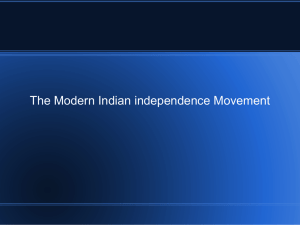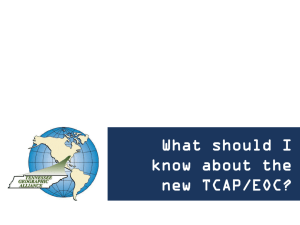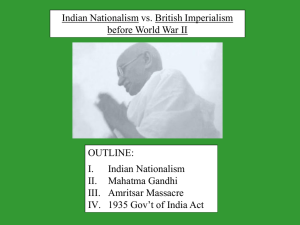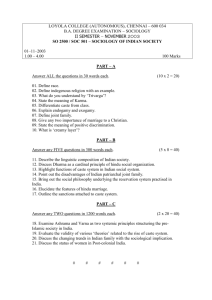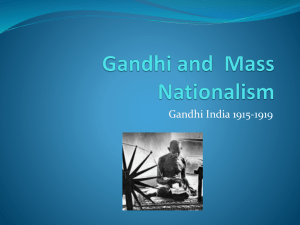HI297: Twentieth Century India: Colonialism, Democracy and Protest
advertisement
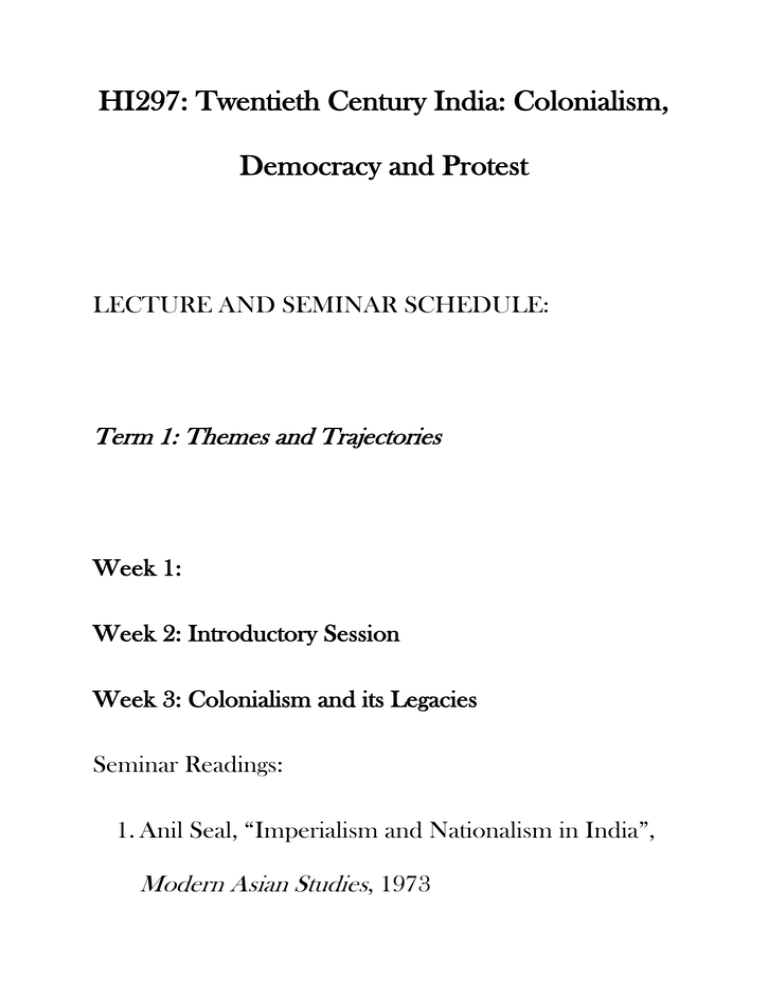
HI297: Twentieth Century India: Colonialism, Democracy and Protest LECTURE AND SEMINAR SCHEDULE: Term 1: Themes and Trajectories Week 1: Week 2: Introductory Session Week 3: Colonialism and its Legacies Seminar Readings: 1. Anil Seal, “Imperialism and Nationalism in India”, Modern Asian Studies, 1973 2. Partha Chatterjee, The Nation and Its Fragments (chapter on the colonial state) Background Readings: 1. Sekhar Bandyopadhyay, From Plassey To Partition 2. Sumit Sarkar, Modern India: 1885-1947, chapter 1. 3. Indivar Kamtekar, “A Different War Dance: State and Class in India 1939-1945” (Past and Present, 2002) 4. Sugata Bose and Ayesha Jalal, Modern South Asia 5. Peter Robb, A History of India Week 4: Indian Democracy, 1947-77 Seminar Readings: 1. Benjamin Zachariah, Nehru (‘Interlude: Envisioning the New India’) 2. Sudipta Kaviraj, “The Passive Revolution and India: A Critique” (from The Trajectories of the Indian State) Background Readings: 1. Ramachandra Guha, India after Gandhi 2. Ayesha Jalal, Democracy and Authoritarianism in South Asia 3. Francine Frankel, India’s Political Economy 1947- 2004 Week 5: Indian Democracy, 1977 – Seminar Readings: 1. Sudipta Kaviraj, “The Passive Revolution and India: A Critique” (from The Trajectories of the Indian State) 2. Sudipta Kaviraj, “The Politics of Liberalization in India” (from The Trajectories of the Indian State) 3. Nivedita Menon and Aditya Nigam: Power and Contestation: India since 1989 (Introduction) Background Readings: 1. Ramachandra Guha, India After Gandhi 2. Ayesha Jalal, Democracy and Authoritarianism in South Asia 3. Siddhartha Deb, The Beautiful and the Damned 4. Pankaj Mishra, Butter Chicken in Ludhiana 5. Achin Vanaik, The Painful Transition: Bourgeois Democracy in India Reading Week Week 7: Gandhian Movements and Indian Politics Seminar Readings: 1. Shahid Amin, “Gandhi As Mahatma” (Subaltern Studies II) 2. Eugene F. Irschick: “Gandhian Non-Violent Protest: Rituals of Avoidance or Rituals of Confrontation?” (Economic and Political Weekly, 1986) 3. JP Narayan, “Gandhi, Vinoba and the Bhoodan Movement” 4. Sumanta Banerjee, “Anna Hazare, Civil Society and the State” (Economic and Political Weekly, 2011) Background Readings: 1. Sumit Sarkar, Modern India 1885-1947 2. Partha Chatterjee, “Gandhi and the Critique of Civil Society” 3. Partha Chatterjee, Nationalist Thought and the Colonial World 4. Ramachandra Guha, Gandhi Before India 5. Faisal Devji, The Impossible Indian: Gandhi and the Temptation of Violence 6. Kathryn Tidrick, Gandhi: A Political and Spiritual Life 7. Bhiku Parekh, Gandhi: A Very Short Introduction 8. Norman Finkelstein, What Gandhi Says 9. Judith Brown, “The Mahatma and Modern India” 10. Harold Coward (ed.) Indian Critiques of Gandhi 11. Arundhati Roy, “The Doctor and the Saint”, available online, Outlook magazine. 12. David Hardiman: Gandhi in his time and ours 13. David Arnold: Gandhi 14. Claude Markovits: The Un-Gandhian Gandhi Week 8: The Long Rise of the Hindu Right Seminar Readings: 1. P.K. Datta: “Dying Hindus: The Production of Communal Commonsense in Early 20th Century Bengal” (EPW, 1993) 2. Chetan Bhatt, Hindu Nationalism, chapters 5 and 6 Background Readings: 1. Gyanendra Pandey, “Rallying around the Cow” 2. Thomas Blom Hansen, The Saffron Wave 3. Christophe Jaffrelot, Hindu Nationalism: A Reader 4. Basu et al, Khaki Shorts, Saffron Flags 5. B.D. Graham, The Hindu Nationalist Movement and Indian Politics 6. Communal Riots in India: A Chronology (19472003) Week 9: The Indian Left Seminar Readings: 1. Stephen Sherlock: “Berlin, Moscow and Bombay: The Marxism That India Inherited” (South Asia, 1998) 2. Manali Desai, State Formation and Radical Politics in India, chapter 6 3. Sudeep Chakrabarti, Red Sun: Travels in Naxalite Country, Introduction 4. Arundhati Roy, “Walking with the Comrades” Background Readings: 1. Sumit Sarkar, Modern India 1885-1947 2. Partha Chatterjee, The Present Politics of West Bengal 3. Nivedita Menon and Aditya Nigam, ‘Old Left, New Left’ (in Power and Contestation: India Since 1989) 4. Rajnarayan Chandavarkar, “From neighbourhood to nation: the rise and fall of the Left in Bombay’s Girangaon in the twentieth century” (in History, Culture and the Indian City) Week 10: Dalit Movements and Caste Politics Seminar Readings: 1. Gerard Baader: “The Depressed Classes in India: Their Struggle for Emancipation” (Studies: An Irish Quarterly Review, 1937) 2. Christophe Jaffrelot: “Sanskritization v. Ethnicization in India: Changing Identities and Caste Politics Before Mandal” (Asian Survey, 2000) 3. Nivedita Menon and Aditya Nigam, “The Recalcitrance of Caste” (from Power and Contestation: India Since 1989) 4. Gail Omvedt, Understanding Caste (pp.48-97 : chapters 7-12) Background Readings: 1. Christophe Jaffrelot, The Silent Revolution 2. B.R. Ambedkar, The Annihilation of Caste 3. Arundhati Roy, ‘Introduction’ to The Annihilation of Caste 4. Sekhar Bandyopadhyay, “Transfer of Power and the Crisis of Dalit Politics in India, 1945-47” 5. Omprakash Valmiki, Joothan. A Dalit’s Life 6. Vasant Moon, Growing up Untouchable in India. A Dalit Autobiography Term 2: Key Texts and Arguments In term 2, the emphasis will shift to political arguments and texts: there will be fewer readings but more intense engagement with individual texts. Week 11: Gandhi, Hind Swaraj Week 12: Gandhi, Hind Swaraj and miscellaneous other writings Week 13: Savarkar, Hindutva Week 14: Savarkar, Hindutva Week 15: Ambedkar, The Annihilation of Caste Reading Week Week 16: Ambedkar, The Annihilation of Caste Week 17: Communist Memoirs and Testimonies (readings TBA) Week 18: Communist Memoirs and Testimonies Week 19: Contemporary Movements (tbc) Week 20: Contemporary Movements (tbc) Week 21: Film Screening and discussion Week 22: Film Screening and discussion Revision Session (tbc) Readings Selected Basic Texts: 1. Ramachandra Guha, India after Gandhi 2. Francine Frankel, India’s Political Economy 1947- 2004 3. Sumit Sarkar, Modern India 1885-1947 4. Sumit Sarkar, Modern Times 5. Sekhar Bandyopadhyay, From Plassey to Partition 6. Peter Robb, A History of India 7. Burton Stein, A History of India 8. Achin Vanaik, The Painful Transition: Bourgeois Democracy in India 9. Sudipta Kaviraj, The Trajectories of the Indian State 10. Partha Chatterjee, The Politics of the Governed 11. Nivedita Menon and Aditya Nigam, Power and Contestation: India since 1989 12. Sugata Bose and Ayesha Jalal, Modern South Asia 13. Benjamin Zachariah, Nehru 14. Benjamin Zachariah, Developing India 15. Vivek Chibber, Locked in Place: State-Building and Late Industrialization in India 16. Thomas and Barbara Metcalf, A Concise History of Modern India 17. Stuart Corbridge et al, Seeing The State: Governance and Governmentality in India 18. Siddhartha Deb, The Beautiful and the Damned 19. Pankaj Mishra, Butter Chicken in Ludhiana 20. C.A. Bayly, Indian Society and the Making of the British Empire 21. K. Balagopal, Ear to the Ground: Selected Writings on Class and Caste (The most important reference texts for the course are highlighted above) Primary Resources: 1. Times of India – you can access the full run of this newspaper from the 1830s to the present through the library’s online resources. It’s invaluable for researchers, and will be very helpful as a supplement to your readings, and to deepen your knowledge of the field. 2. British Parliamentary Papers – also online through the library’s database collection 3. Collected Works of Mahatma Gandhi, available online 4. Collected Works of Jawaharlal Nehru, available online 5. Youtube resources: Indian internet resources are usually less than reliable – there’s a great deal of bigotry and hate speech masquerading as historical knowledge. Nevertheless, there are some invaluable resources. On Youtube’s British Pathe channel, you can find thousands of videos about modern Indian history, of variable lengths – great footage. Journals: Since much of the period under discussion in the module is unevenly covered by available monographs, academic and non-academic journals and magazines furnish some of the more reliable accounts available. All of these are either in the public domain or available through the library’s online resources. Academic Journals: Economic and Political Weekly Indian Economic and Social History Review Modern Asian Studies Comparative Studies in South Asia, Africa and the Middle East Comparative Studies in Society and History Indian Historical Review South Asia Journal of Peasant Studies Past and Present “Non-Academic” Journals and Magazines: Caravan magazine Outlook magazine Seminar Tehelka The Hindu (newspaper, available online) The Guardian (very occasional coverage, but check out the writings of Priyamvada Gopal and Pankaj Mishra on the website) Essays Essay Questions: 1. How did political conflicts in the late-colonial era mark the politics of the post-Independence period? 2. What was the ‘Congress system’ in Indian politics? How and why did it enter into crisis? 3. Why was Gandhi able to mobilize mass support among the Indian peasantry? 4. What was ‘Nehruvian socialism’? 5. Why was socialism such a widely shared point of reference in post-Independence politics, and how have matters changed in this regard? 6. Discuss the concept of ‘passive revolution’, with reference to the post-colonial Indian state. 7. Why was Emergency declared in 1975? 8. Discuss the major shifts in the history of Indian Communism up till Independence. 9. How did economic liberalization transform Indian politics? 10. Why did the Hindu Right grow so rapidly from the 1980s onward? 11. Discuss the case for Indian freedom laid out in Gandhi’s Hind Swaraj. 12. What were the distinctive features of Gandhi’s conception of Swaraj? 13. Discuss the main features of Ambedkar’s critique of the caste system, as laid out in his Annihilation of Caste. 14. Was Gandhi a nationalist? 15. On what basis did Savarkar make the case for India as a Hindu nation? 16. What impact did the destruction of the Babri Masjid have upon Indian democracy? 17. Discuss the main shifts in Dalit politics since Independence. 18. Explore the way in which political motifs are formulated in any one of the following films: 1. Gandhi, 2. Rang de Basanti , 3. Shri 420, 4. Mother India, 5. Hazaaron Khwaishen Aisi 6. Kathapurushan 19. Discuss the main tensions within the Indian Left after Independence, and analyse their consequences. 20. How did Savarkar, Ambedkar and Gandhi’s political visions differ? 21. Did Indian politics change fundamentally after the Emergency? 22. Did colonialism fracture or integrate Indian society and politics?



